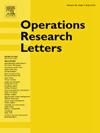改进了联合概率和发生事件数的边界
IF 0.9
4区 管理学
Q4 OPERATIONS RESEARCH & MANAGEMENT SCIENCE
引用次数: 0
摘要
设A1,A2,…,An是样本空间中的事件。给定最多k+1个事件集合的交集的概率,我们能说至少r个事件发生的概率是多少?这个问题可以追溯到19世纪的布尔,众所周知,包含-排除公式的奇数部分和提供上界,而偶数部分和提供下界。我们给出了这些界内误差的组合表征,并利用它推导出一个非常简单的证明,证明了某种形式的最强可能界,以及几个改进的界。与经典的bonferroni型不等式相比,新的边界使用了更多的信息,而且通常更清晰。本文章由计算机程序翻译,如有差异,请以英文原文为准。
Improved bounds on the probability of a union and on the number of events that occur
Let be events in a sample space. Given the probability of the intersection of each collection of up to of these events, what can we say about the probability that at least r of the events occur? This question dates back to Boole in the 19th century, and it is well known that the odd partial sums of the Inclusion-Exclusion formula provide upper bounds, while the even partial sums provide lower bounds. We give a combinatorial characterization of the error in these bounds and use it to derive a very simple proof of the strongest possible bounds of a certain form, as well as a couple of improved bounds. The new bounds use more information than the classical Bonferroni-type inequalities, and are often sharper.
求助全文
通过发布文献求助,成功后即可免费获取论文全文。
去求助
来源期刊

Operations Research Letters
管理科学-运筹学与管理科学
CiteScore
2.10
自引率
9.10%
发文量
111
审稿时长
83 days
期刊介绍:
Operations Research Letters is committed to the rapid review and fast publication of short articles on all aspects of operations research and analytics. Apart from a limitation to eight journal pages, quality, originality, relevance and clarity are the only criteria for selecting the papers to be published. ORL covers the broad field of optimization, stochastic models and game theory. Specific areas of interest include networks, routing, location, queueing, scheduling, inventory, reliability, and financial engineering. We wish to explore interfaces with other fields such as life sciences and health care, artificial intelligence and machine learning, energy distribution, and computational social sciences and humanities. Our traditional strength is in methodology, including theory, modelling, algorithms and computational studies. We also welcome novel applications and concise literature reviews.
 求助内容:
求助内容: 应助结果提醒方式:
应助结果提醒方式:


